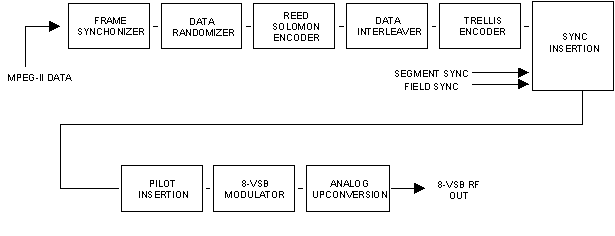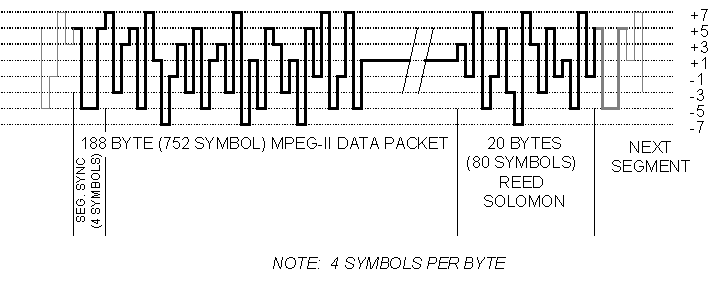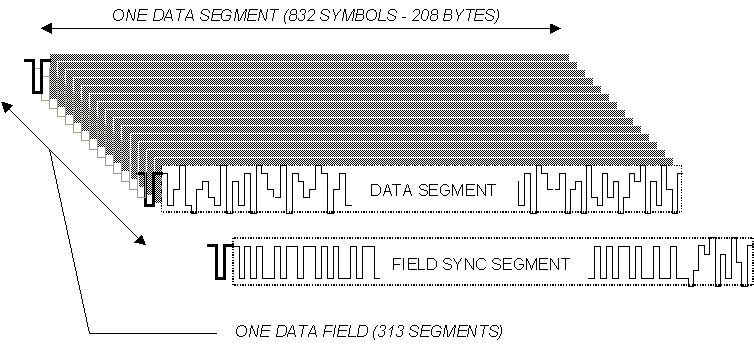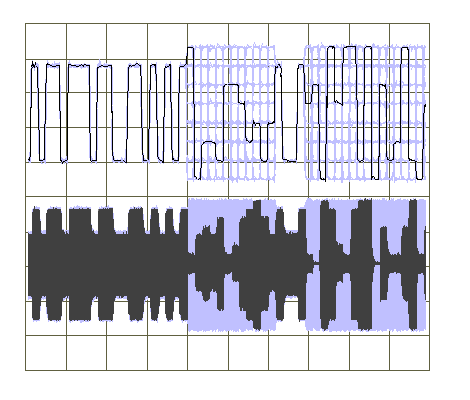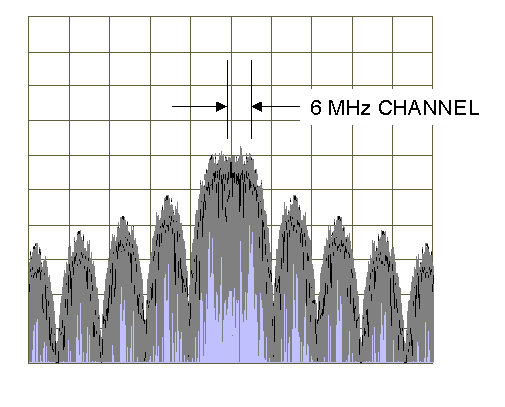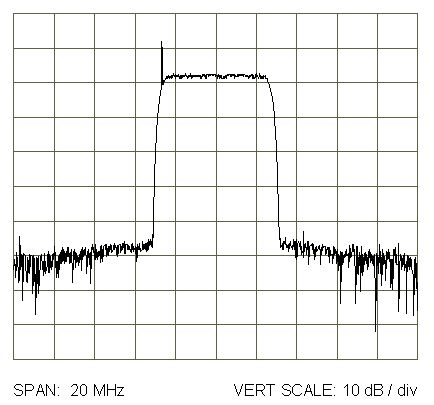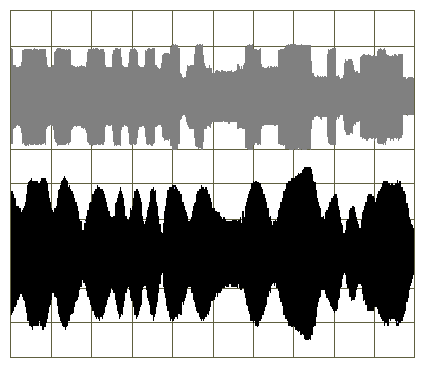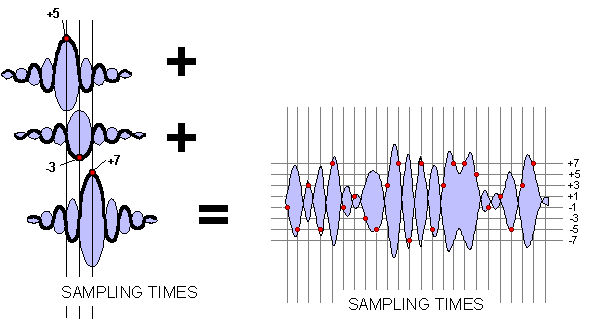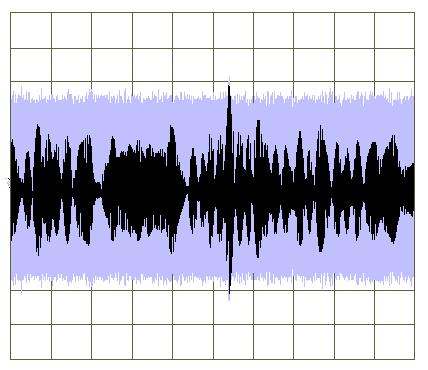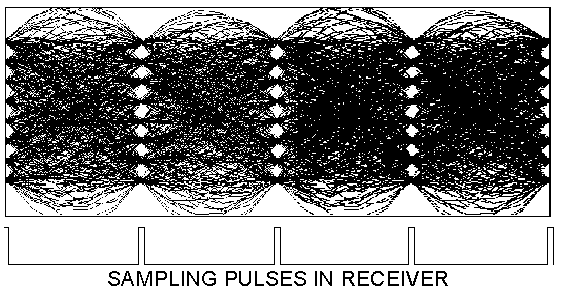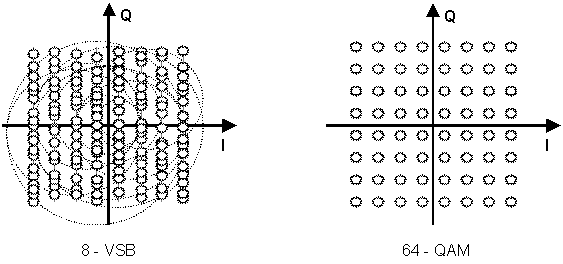WHAT EXACTLY IS 8-VSB ANYWAY?NOTE: You may need to adjust your Page Setup - Margins settings to correctly print this page. The USA invented it, the ATTC tested it, the FCC accepted it, everyone is talking about it, soon we will all get it in our homes - but what is 8-VSB anyway? Simply put, 8-VSB is the RF modulation format utilized by the DTV (ATSC) digital television standard to transmit digital bits over the airwaves to the home consumer. Since any terrestrial TV system must overcome numerous channel impairments such as ghosts, noise bursts, signal fades, and interference in order to reach the home viewer, the selection of the right RF modulation format is critical. The 8-VSB format is the cornerstone upon which the DTV standard is based; developing a basic understanding of 8-VSB is imperative for those who will be working around DTV in the future. In the alphabet soup world of digital communications, there are two big names to remember when thinking about the complete DTV system: 8-VSB and MPEG-II. 8-VSB is the RF modulation format and MPEG-II is the video compression/packetization format. To convert high definition studio video into a form suitable for over-the-air broadcast, according to DTV standards, two stages of processing are needed: MPEG-II encoding and 8-VSB modulation. Accordingly, two major pieces of equipment are required: an MPEG-II encoder and an 8-VSB exciter. The MPEG-II encoder takes baseband digital video and performs bit rate compression using the techniques of discrete cosine transform, run length coding, and bi-directional motion prediction - all of which are beyond the scope of this article. The MPEG-II encoder then multiplexes this compressed video information together with pre-coded Dolby AC-3 audio and any ancillary data that will be transmitted. The result is a stream of highly compressed MPEG-II data packets with a data frequency of only 19.39 Mbit/Sec. This is by no means a trivial task since the high resolution digital video (or multiple standard resolution video) input to the MPEG-II encoder could easily have a data rate of 1 Gbit/sec or more. This 19.39 Mbit/sec data stream is known as the DTV Transport Layer. It is output from the MPEG-II encoder and input to the 8-VSB exciter in serial form, according to the SMPTE-310 interface standard. Although MPEG-II compression techniques can achieve stunning bit-rate reduction results, still more tricks must be employed to squeeze the 19.39 Mbit/sec DTV Transport Layer signal into a slender 6 MHz RF channel and transmit it (hopefully without errors) to the eager consumer waiting at home in front of the TV set. This is the job of the 8-VSB exciter. Figure 1 is a block diagram of a typical 8-VSB exciter. In this article, we will walk through the major processes that occur in the 8-VSB exciter - identifying the major components of the 8-VSB signal and explaining how this signal is generated.
FIGURE 1: BLOCK DIAGRAM, 8-VSB EXCITER DATA SYNCHRONIZATION The first thing that the 8-VSB exciter does upon receiving the MPEG-II data packets is to synchronize its own internal circuits to the incoming signal. Before any signal processing can occur, the 8-VSB exciter must correctly identify the start and end points of each MPEG-II data packet. This is accomplished using the MPEG-II sync byte. MPEG-II packets are 188 bytes in length with the first byte in each packet always being the sync byte. The MPEG-II sync byte is then discarded; it will ultimately be replaced by the ATSC segment sync in a later stage of processing. DATA RANDOMIZER With the exception of the segment and field syncs (to be discussed later), the 8-VSB bit stream must have a completely random, noise-like nature. This is because our transmitted signal frequency response must have a flat noise-like spectrum in order to use the allotted channel space with maximum efficiency. If our data contained repetitious patterns, the recurring rhythm of these patterns would cause the RF energy content of our transmitted signal to "lump" together at certain discrete points in our frequency spectrum, thereby leaving holes at other frequencies. This implies that certain parts of our 6 MHz channel would be overused, while other parts would be underused. Plus, the large concentrations of RF energy at certain modulating frequencies would be more likely to create discernible beat patterns in an NTSC television set, if DTV-to-NTSC interference were experienced. In the data randomizer, each byte value is changed according to known pattern of pseudo-random number generation. This process is reversed in the receiver in order to recover the proper data values. REED-SOLOMON ENCODING Reed Solomon encoding is a Forward Error Correction (FEC) scheme applied to the incoming data stream. Forward error correction is a general term used to describe a variety of techniques that can be used to correct bit errors that occur during transmission. Atmospheric noise, multipath propagation, signal fades, and transmitter non-linearities may all create received bit errors. Forward error correction can detect and correct these errors, up to a reasonable limit. The Reed-Solomon encoder takes all 187 bytes of an incoming MPEG-II data packet (the packet sync byte has been removed) and mathematically manipulates them as a block to create a sort of "digital thumbnail sketch" of the block contents. This "sketch" occupies 20 additional bytes which are then tacked onto the tail end of the original 187 byte packet. These 20 bytes are known as Reed-Solomon parity bytes The receiver will compare the received 187 byte block to the 20 parity bytes in order to determine the validity of the recovered data. If errors are detected, the receiver can use the parity bytes to locate the exact location of the errors, modify the corrupted bytes, and reconstruct the original information. Up to 10 byte errors per packet can be corrected this way. If too many byte errors are present in a given packet, the parity "thumbnail sketch" no longer resembles the received data block, the validity of the data can no longer be confirmed, and the entire MPEG-II packet must be discarded. DATA INTERLEAVER The data interleaver scrambles the sequential order of the data stream and disperses the MPEG-II packet data throughout time (over a range of about 4.5 msec through the use of memory buffers) in order to minimize the transmitted signal's sensitivity to burst type interference. The data interleaver then assembles new data packets incorporating tiny fragments from many different MPEG-II (pre-interleaved) packets. These reconstituted data packets are the same length as the original MPEG-II packets: 207 bytes (after Reed-Solomon coding). This is the equivalent of spreading all of your eggs (bytes) over many different (time) baskets. If a noise burst punches a hole in the signal during propagation and "one basket" is lost (i.e. several milliseconds), many different MPEG-II packets lose one egg instead of one MPEG-II packet losing all of its eggs. This is known as time diversity. Data interleaving is done according to a known pattern; the process is reversed in the receiver in order to recover the proper data order. TRELLIS ENCODER Trellis coding is yet another form of forward error correction. Unlike Reed-Solomon coding, which treated the entire MPEG-II packet simultaneously as a block, trellis coding is an evolving code that tracks the progressing stream of bits as it develops through time. Accordingly, Reed-Solomon coding is known as a form of block code, while trellis coding is a convolutional code. For trellis coding, each 8-bit byte is split up into a stream of four, 2-bit words. In the trellis coder, each 2-bit word that arrives is compared to the past history of previous 2-bit words. A 3-bit binary code is mathematically generated to describe the transition from the previous 2-bit word to the current one 1. These 3-bit codes are substituted for the original 2-bit words and transmitted over-the-air as the eight level symbols of 8-VSB (3 bits = 23 = 8 combinations or levels). For every two bits that go into the trellis coder, three bits come out. For this reason, the trellis coder in the 8-VSB system is said to be a 2/3 rate coder. The trellis decoder in the receiver uses the received 3-bit transition codes to reconstruct the evolution of the data stream from one 2-bit word to the next. In this way, the trellis coder follows a "trail" as the signal moves from one word to the next through time. The power of trellis coding lies in its ability to track a signal's history through time and discard potentially faulty information (errors) based on a signal's past and future behavior. This is somewhat like following one person's footsteps through the snow on a busy sidewalk. When the trail becomes confused with other tracks (i.e. errors are received), the trellis decoder has the ability to follow several possible "trails" for a few footprints and make a decision as to which prints are the correct ones. (Note: change this analogy to "footprints in the sand on a crowded beach" if you are reading this article in a warm climate.) SYNC & PILOT INSERTION The next step in the signal processing chain is the insertion of the various "helper" signals that aid the 8-VSB receiver in accurately locating and demodulating the transmitted RF signal. These are the ATSC pilot, segment sync, and field sync. The pilot and sync signals are inserted after the randomization and error coding stages so as not to destroy the fixed time and amplitude relationships that these signals must possess to be effective. Recovering a clock signal in order to decode a received waveform has always been a tricky proposition in digital RF communications. If we derive the receiver clock from the recovered data, we have a sort of "chicken and egg" dilemma. The data must be sampled by the receiver clock in order to be accurately recovered. The receiver clock itself must be generated from accurately recovered data. The resulting clocking system quickly "crashes" when the noise or interference level rises to a point that significant data errors are received. When NTSC was invented, the need was recognized to have a powerful sync pulse that rose above the rest of the RF modulation envelope. In this way, the receiver synchronization circuits could still "home in" on the sync pulses and maintain the correct picture framing - even if the contents of the picture were a bit snowy. (Everyone saw the need for this except the French; sync there is the weakest part of the signal - vive la différence). NTSC also benefited from a large residual visual carrier (caused by the DC component of the modulating video) that helped TV receiver tuners zero in on the transmitted carrier center frequency. 8-VSB employs a similar strategy of sync pulses and residual carriers that allows the receiver to "lock" onto the incoming signal and begin decoding, even in the presence of heavy ghosting and high noise levels. The first "helper" signal is the ATSC pilot. Just before modulation, a small DC shift is applied to the 8-VSB baseband signal (which was previously centered about zero volts with no DC component). This causes a small residual carrier to appear at the zero frequency point of the resulting modulated spectrum. This is the ATSC pilot. This gives the RF PLL circuits in the 8-VSB receiver something to lock onto that is independent of the data being transmitted. Although similar in nature, the ATSC pilot is much smaller than the NTSC visual carrier, consuming only 0.3 dB or 7 percent of the transmitted power. The other "helper" signals are the ATSC segment and field syncs. An ATSC data segment is comprised of the 207 bytes of an interleaved data packet. After trellis coding, our 207 byte segment has been stretched out into a baseband stream of 828 eight level symbols. The ATSC segment sync is a four symbol pulse that is added to the front of each data segment and replaces the missing first byte (packet sync byte) of the original MPEG-II data packet. The segment sync appears once every 832 symbols and always takes the form of a positive-negative-positive pulse swinging between the +5 and -5 signal levels (see Figure 2). Correlation circuits in the 8-VSB receiver home in on the repetitive nature of the segment sync, which is contrasted against the background of pseudo-random data (remember the data randomizer processing stage). The recovered segment sync is used by the receiver to regenerate the system clock and sample the received signal. Because of their high frequency of repetition, large signal level swing, and extended duration, the segment syncs are easy for the receiver to spot. As a result, accurate clock recovery can be had at noise and interference levels well above those where data recovery is impossible (up to 0 dB SNR - data recovery requires at least 15 dB SNR). This robust synchronization system, along with ATSC pilot, allows the receiver to quickly recover lock-up during channel changes and other transient conditions. Figure 2 shows the make-up of the ATSC data segment and the position of the ATSC segment sync.
An ATSC data segment is roughly analogous to an NTSC line; ATSC segment sync is somewhat like NTSC horizontal sync. Their duration and frequencies of repetition are, of course, completely different. Each ATSC segment sync lasts 0.37 msec; NTSC sync lasts 4.7 msec. An ATSC data segment lasts 77.3 msec; an NTSC line 63.6 msec. A careful inspection of the numbers involved reveals that the ATSC segment sync is somewhat more "slender" when compared to its NTSC counterpart. This is done to maximize the active data payload and minimize the time committed to sync "overhead". Three hundred and thirteen consecutive data segments are combined to make a data field. Figure 3 shows the make-up of an ATSC data field. The ATSC field sync is an entire data segment that is repeated once per field (24.2 msec) and is roughly analogous to the NTSC vertical interval.2 The ATSC field sync has a known data symbol pattern of positive-negative pulses and is used by the receiver to eliminate signal ghosts caused by poor reception. This is done by comparing the received field sync with errors against the known field sync sequence before transmission. The resulting error vectors are used to adjust the taps of the receiver ghost-canceling equalizer. Like segment syncs, the large signal level swing and repetitive nature of field syncs allow them to be successfully recovered at very high noise and interference levels (up to 0 dB SNR).
FIGURE 3: ATSC BASEBAND DATA FIELD At the end of each field sync segment,
the last twelve
The robustness of the segment and field syncs permits accurate clock recovery and ghost-canceling operation in the 8-VSB receiver, even when the active data payload is completely corrupted by poor reception conditions. This allows the adaptive ghost-canceling equalizer to "hunt around in the mud" and recover a useable signal before the data payload has been successfully decoded - thus eliminating the "chicken and egg dilemma" described earlier. AM MODULATION Our eight level baseband DTV signal, with syncs and DC pilot shift added, is then amplitude modulated onto an intermediate frequency (IF) carrier. This creates a large, double sideband IF spectrum about our carrier frequency, as is shown in Figure 5. The occupied bandwidth of this IF signal is far too wide to be transmitted in our assigned 6 MHz channel. Fortunately, there are tricks we can employ to filter away a large part of this spectrum without destroying any of the digital information we wish to transmit. A simple inspection of Figure 5 reveals the high degree of redundancy in our double sideband AM spectrum. The various sidelobes are simply scaled copies of the center spectrum, and the entire lower sideband is a mirror image of the upper sideband. This allows us to discard almost the entire lower sideband and all of the sidelobes in the upper sideband. The remaining signal (upper half of the center spectrum) can be further cut in half by virtue of the Nyquist Theory, which states that only a 1/2 frequency bandwidth is required to transmit a digital signal at a given sampling rate.3 The job of trimming the double sideband IF spectrum down to size falls to the next processing stage, the Nyquist filter 4.
Top: The eight level baseband signal
at the end of a field sync segment.
Bottom: A (different) field sync
segment after AM modulation onto the IF carrier.
The double sideband RF spectrum
created by the AM modulation of the baseband
NYQUIST FILTER As a result of the data overhead added to the signal stream in the form of forward error correction coding and sync insertion, our data rate has gone from 19.39 Mbit/sec at the exciter input to 32.28 Mbit/sec at the output of the trellis coder. Since 3 bits are transmitted in each symbol of the 8-level 8-VSB constellation, the resulting symbol rate is 32Mb / 3 = 10.76 Million symbols/sec. By virtue of the Nyquist Theorem, we know that 10.76 Million symbols/sec can be transmitted in a vestigial sideband signal (VSB)5 with a minimum frequency bandwidth of 1/2 * 10.76 MHz = 5.38 MHz. Since we are allotted a channel bandwidth of 6 MHz, we can relax the steepness of our VSB filter skirts slightly and still fall within the 6 MHz channel. This permissible excess bandwidth (represented by a, the Greek letter alpha), is 11.5% for the ATSC 8-VSB system. That is, 5.38 MHz (minimum bandwidth per Nyquist) + 620 kHz (11.5% excess bandwidth) = 6.00 MHz (channel bandwidth used). The higher the alpha factor used, the easier the hardware implementation is, both in terms of filter requirements and clock precision for sampling. The resulting frequency response after the Nyquist VSB filter is shown in Figure 6. Note how, like traditional NTSC, the 8-VSB format utilizes a vestigial sideband approach in the interest of conserving spectrum space. Unlike NTSC, however, 8-VSB takes this concept to greater extremes: the lower RF sideband is almost completely removed.
Note presence of ATSC pilot at lower
edge of channel. The lower
This virtual elimination of the lower sideband, along with the narrowband filtering of the upper sideband, creates very significant changes in the RF waveform that is ultimately transmitted. The 8-VSB IF envelope undergoes a transformation and loses the neat, "8-level stairstep" appearance that it had before filtering. The train of "squared-off" symbol pulses that made up the double-sideband IF signal is modified by the impulse response of the narrowband Nyquist filter. This is shown in Figure 7.
FIGURE 7: EFFECT OF NYQUIST FILTER ON 8-VSB IF ENVELOPE Top: Double sideband IF envelope before Nyquist filtering. Bottom: The same IF signal after
Nyquist filtering. The squared-off
After considering Figure 7, the natural reaction is to ask "what happened to the eight levels?" and to wonder if all of the information contained in those eight levels has been lost forever. The answer is no; the following paragraphs explain why: As any video or transmitter engineer knows, when a square signal pulse is frequency bandlimited, it will lose its square edges and "ring" (oscillate) in time before and after the initial pulse. For our digital 8-level signal, this would spell disaster as the pre- and post-ringing from one symbol pulse would interfere with the preceding and following pulses - thereby distorting their levels and disrupting their information content. Fortunately, there is still a way to transmit our 8-VSB symbol pulses if we observe that the eight level information is only recognized during the precise instant of sampling in the receiver. At all other times, the symbol pulse amplitude is unimportant and can be modified in any way we please - so long as the amplitude at the precise instant of sampling still assumes one of the required eight amplitude levels. If the narrowband frequency filtering is done correctly according to the Nyquist Theorem, the resulting train of symbol pulses will be orthogonal. This means that at each precise instant of sampling, only one symbol pulse will contribute to the final RF envelope waveform; all preceding and following symbol pulses will be experiencing a zero crossing in their amplitude at that point in time. This is shown in Figure 8. In this way, when the RF waveform is sampled by the receiver clock, the recovered voltage will represent only the current symbol's amplitude (one of the eight possible levels).6
FIGURE 8: ADDITION OF NARROWBAND, ORTHOGONAL SYMBOL PULSES At any given sampling time (vertical
line), only one symbol pulse contributes
At all times in-between the sampling times, the total RF envelope waveform is the addition of the "ringing" of dozens of previous and future symbols (since all symbols have non-zero amplitudes between sampling times). Note that, in the interest of simplicity, Figure 8 shows our narrowband symbol pulses as ringing for only 10 sampling periods; in reality they ring for a much longer time. These non-zero values (between sampling times) from dozens of symbols can add up to very large signal voltages. The result is a very "peaky" signal that most closely resembles white noise. This is shown in Figure 9. The peak to average ratio of this signal can be as high as 12 dB, although RF peak clipping in the transmitter can limit this value to 6 - 7 dB with minimal consequences.
FIGURE 9: THE 8-VSB RF WAVEFORM AT THE EXCITER OUTPUT The black regions represent the
current oscilloscope trace;
8-VSB EYE DIAGRAM One popular representation of the 8-VSB signal that emphasizes the principals just discussed is the 8-VSB eye diagram. This diagram turns up in the pages of many articles on 8-VSB and on the screens of many pieces of 8-VSB test equipment. The eye diagram is the overlay of many traces of the received RF signal amplitude at the instant of sampling. Since the RF signal must attain one of eight possible levels whenever a sampling time occurs (somewhat like when the music stops in the game of musical chairs), the convergence of the many signal traces forms seven "eyes" that coincide with the occurrence of clock pulses in the receiver. This is shown in Figure 10.
FIGURE 10: THE 8-VSB EYE DIAGRAM At each sampling time, the demodulated
RF amplitude assumes one of eight possible levels.
8-VSB SIGNAL CONSTELLATION Another popular representation of the 8-VSB signal that is common to many pieces of test equipment is the 8-VSB signal constellation. This is a two dimensional graphical representation of the 8-VSB RF carrier amplitude and phase at each sampling time. In 8-VSB, the digital information is transmitted exclusively in the amplitude of the RF envelope and not in the phase. This is unlike other digital modulation formats, such as QAM, where each point in the signal constellation is a certain vector combination of carrier amplitude and phase. A QAM-like arrangement is not possible in 8-VSB since the carrier phase is no longer an independent variable under our control, but is rather "consumed" in suppressing the lower sideband. The 8-VSB signal constellation, as compared to 64-QAM, is shown in Figure 11. Our eight levels are recovered by sampling an in-phase (I channel) synchronous detector. Nothing would be gained by sampling a quadrature (Q) channel detector since no useful information is contained in this channel. Our signal constellation diagram is therefore a series eight vertical lines that correspond to our eight transmitted amplitude levels. By eliminating any dependence on the Q-channel, the 8-VSB receiver need only process the I channel, thereby cutting in half the number of DSP circuits required in certain stages. The result is greater simplicity, and ultimately cost savings, in the receiver design.
FIGURE 11: 8-VSB SIGNAL CONSTELLATION vs 64-QAM 8-VSB signal constellation is a
series of eight vertical lines on the I (in-phase) axis. The Q
ANALOG UPCONVERSION AND THE REST OF THE 8-VSB CHAIN After the Nyquist VSB filter, the 8-VSB intermediate frequency (IF) signal is up-converted by traditional oscillator-mixer-filter circuits to the assigned channel frequency in the UHF or VHF band. The on-channel RF output of the 8-VSB exciter is then supplied to the DTV transmitter. The transmitter is essentially a traditional RF power amplifier, be it solid state or tube-type. A high-power RF output system filters the transmitter output signal and suppresses any spurious out-of-band signals caused by transmitter non-linearities. The last link in the transmitting chain is the antenna which broadcasts the full-power, on-channel 8-VSB DTV signal. In the home receiver, the over-the-air signal is demodulated by essentially applying in reverse the same principals that we have already discussed. The incoming RF signal is received, downconverted, filtered, then detected. The segment and field syncs are recovered. Segment syncs aid in receiver clock recovery and field syncs are used to train the adaptive ghost-canceling equalizer. Once the proper data stream has been recovered, it is trellis decoded, de-interleaved, Reed-Solomon decoded, and de-randomized. The end result is the recovery of the original MPEG-II data packets. MPEG-II decoding circuits reconstruct the video image for display on the TV screen. Dolby AC-3 circuits decode the sound information and drive the receiver loudspeakers. The home viewer "receives his DTV" and the signal chain is complete. CONCLUSION The goal of this article has been to provide some insight into the inner workings of the 8-VSB transmission system. Like many things in life, 8-VSB can appear formidable at first, but is really quite simple "once you get to know it." Hopefully the knowledge conveyed in this article will dispel some of the fear factor that many NTSC engineers experience when faced with the unknown world of digital TV. So what then is 8-VSB? Simply put, 8-VSB is the future of American television ... and the future doesn't have to be such a scary thing. ACKNOWLEDGEMENTS Special thanks go to Bob Plonka, Joe Seccia, and Ed Twitchell of Harris Corporation Broadcast Division for their contributions of time, material, and assistance in writing this article. Special thanks also go to Karl Black and Robert Uhl for their proofreading assistance. REFERENCES
AUTHOR David Sparano received a Bachelor of Science degree from Siena College and a Master of Science degree from Rensselaer Polytechinc Institute. He is currently TV Installations Manager with Harris Corporation Broadcast Systems Division in Quincy, Illinois. Mr. Sparano is fluent in four languages and has presented seminars on DTV throughout North and South America.
1 The trellis coder in the DTV system actually leapfrogs ahead twelve symbols at a time to determine the next symbol transition. There are then twelve different trellis codes operating in parallel (e.g. symbol 0 links with 12, 24, 36.... symbol 1 links with 13, 25, 37... symbol 2 links with 14, 26, 38... etc.). This is yet another form of interleaving and offers some additional protection against burst-type noise. It is also designed to work well in conjunction with an NTSC interference rejection filter in the receiver that makes use of a twelve symbol tapped delay line. 2 Note, however, that unlike NTSC, the ATSC syncs do not play any role in the framing of the displayed image on the receiver picture tube. This information is encoded digitally as part of the MPEG packet address information. 3 Reverse the order of this statement and you have the principal behind the minimum " 2x frequency response" sampling rate for CD players and other digital audio devices. 4 There are several different ways to implement the AM modulation, VSB filtering, and pilot insertion stages of the 8-VSB exciter, some of which are completely digital and involve direct digital synthesis of the required waveforms. All methods aim to achieve the same results at the exciter output. This particular arrangement was chosen in the interest of providing a clear, easily understandable, signal flow diagram. Note: The Harris CD series of 8-VSB exciters employ all digital signal synthesis. 5 Note: 8-VSB = 8 level - Vestigial Side Band 6 A subtle clarification: The 8-VSB system actually employs a matched pair of Nyquist filters - one in the exciter (to reduce transmitted bandwidth), another in the receiver (to eliminate adjacent channel interference). Each Nyquist filter provides one-half of the orthogonal impulse response described above. The effect shown in Figure 8, therefore, does not fully exist when the RF signal is transmitted, but rather only after it is filtered for a second time in the receiver. |
